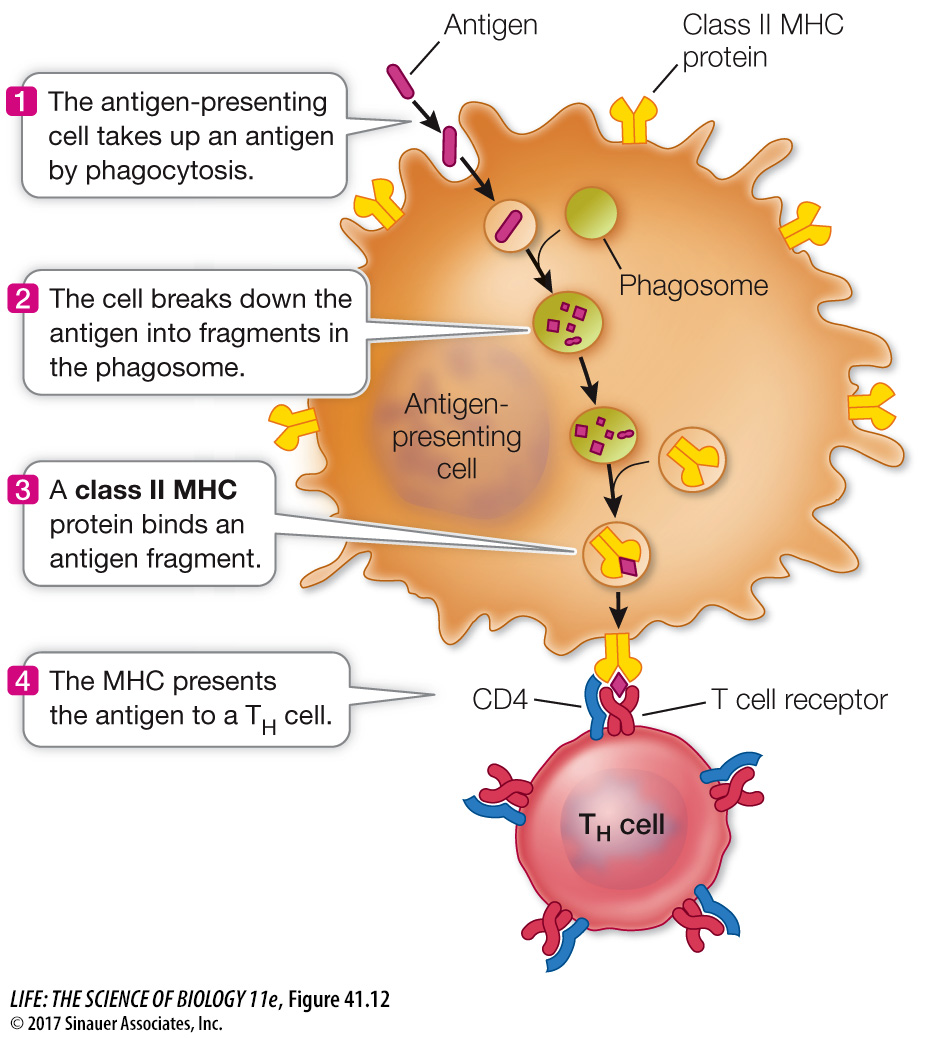MHC proteins present antigen to T cells, causing recognition
883
Both TH and TC cells express T cell receptors that bind to antigen on the cell surface. But the response of each cell type to binding is quite different. TH binding results in activation of the adaptive immune response, whereas TC binding results in death of the cell carrying the antigen. MHC proteins form complexes with antigens on cell surfaces and assist with recognition by the T cells, so that the appropriate type of T cell binds.
The MHC proteins are cell membrane glycoproteins. Two types of MHC proteins function to present antigens to the two different types of T lymphocytes:
Class I MHC proteins are present on the surface of every nucleated cell in the mammalian body. They present antigens to TC cells. These antigens can be fragments of virus proteins in virus-
infected cells or abnormal proteins made by cancer cells as a result of somatic mutations. A TC cell with the appropriate T cell receptor binds to the MHC- antigen complex. To ensure binding, the TC cell also has a cell surface receptor protein called CD8 that recognizes and binds to MHC I. Class II MHC proteins are on the surfaces of macrophages, B cells, and dendritic cells. They present antigens to TH cells. The three cell types ingest antigens and break them down; one of the fragments then binds to MHC II for presentation (Figure 41.12). A TH cell with the appropriate T cell receptor binds to the MHC-
antigen complex. To ensure binding, the TH cell also has a cell surface receptor protein called CD4 that recognizes and binds to MHC II.  Figure 41.12 Macrophages Are Antigen-
Figure 41.12 Macrophages Are Antigen-Presenting Cells A fragment of an antigen is displayed by MHC II on the surface of a macrophage. T cell receptors on a specific TH cell can then bind to and interact further with the antigen– MHC II complex.
In humans there are three genetic loci for class I MHC proteins and three for class II MHC proteins. Each of these six loci has as many as 100 different alleles. With so many possible allele combinations, it is not surprising that different people are very likely to have different MHC genotypes. This is why it can be difficult to find a good “match” for organ donations. MHC proteins are “self” markers. To accomplish its role in antigen presentation, an MHC protein has an antigen-
Information on MHC proteins, the cellular origins of antigens, and T lymphocytes is summarized in Table 41.3.
| Presenting cell type | Antigen presented | MHC class | T cell type | T cell surface protein |
|---|---|---|---|---|
| Any cell | Intracellular protein fragment | Class I | Cytotoxic T cell (TC) | CD8 |
| Macrophages, dendritic cells, and B cells | Fragments from extracellular proteins | Class II | Helper T cell (TH) | CD4 |